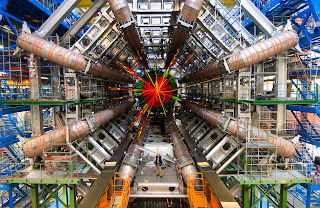To “hear” the data we can map physical properties (The Data) to audible properties (The Sound) in pretty much any way we choose. For a physicist, an obvious way to do this might be to map speed to pitch. I think this is obvious for a physicist because both of these things are measured “per second” (pitch or frequency is measured in Hertz, which means vibrations per second). But we don’t have to do the obvious, we can map any physical property to any audible property. In this example I’m going to map speed to the pitch of the note, length/position to the duration of the note and number of turns/legs/puffs to the loudness of the note. Now I have to choose starting positions and ranges. When I do this I have to consider that:How to make sound out of anything.
We know that colour is a psychophysical experience of an observer which changes from observer to observer and is therefore impossible to replicate absolutely. In order to quantify colour in meaningful terms we must be able to measure or represent the three attributes that together give a model of colour perception. i.e. light, object and the eye. All these attributes have been standardised by the CIE or Commission Internationale de l'Eclairage. The colours of the clothes we wear and the textiles we use in our homes must be monitored to ensure that they are correct and consistent. Colour measurement is therefore essential to put numbers to colour in order to remove physical samples and the interpretation of results.See:Colour measuring equipment
In the arts and of painting, graphic design, and photography, color theory is a body of practical guidance to color mixing and the visual impact of specific color combinations. Although color theory principles first appear in the writings of Alberti (c.1435) and the notebooks of Leonardo da Vinci (c.1490), a tradition of "colory theory" begins in the 18th century, initially within a partisan controversy around Isaac Newton's theory of color (Opticks, 1704) and the nature of so-called primary colors. From there it developed as an independent artistic tradition with only sporadic or superficial reference to colorimetry and vision science.See: Color Theory
CIE L*a*b* (CIELAB) is the most complete color model used conventionally to describe all the colors visible to the human eye. It was developed for this specific purpose by the International Commission on Illumination (Commission Internationale d'Eclairage, hence its CIE initialism). The * after L, a and b are part of the full name, since they represent L*, a* and b*, derived from L, a and b. CIELAB is an Adams Chromatic Value Space. The three parameters in the model represent the lightness of the color (L*, L*=0 yields black and L*=100 indicates white), its position between magenta and green (a*, negative values indicate green while positive values indicate magenta) and its position between yellow and blue (b*, negative values indicate blue and positive values indicate yellow). The Lab color model has been created to serve as a device independent model to be used as a reference. Therefore it is crucial to realize that the visual representations of the full gamut of colors in this model are never accurate. They are there just to help in understanding the concept, but they are inherently inaccurate. Since the Lab model is a three dimensional model, it can only be represented properly in a three dimensional space.See: CIE 1976 L*, a*, b* Color Space (CIELAB)So in a sense we have developed "a method" by which application of color in this case would be used. Is it highly subjective in one's own case without some kind of metered measure and one would have to consider, by which consensus such a model would be applied(production of specific colours chemically induced for instance) to have a desired effect.
Evan Grant Making sound visible through cymatics
I give this link above in order to establish that sound can have an architectural correlation in terms of a vibrational signature. Has a qualitative signature of sorts.So for me as I moved ahead in this blog format it was important for me to see how sound can be used.
Space, we all know what it looks like. We've been surrounded by images of space our whole lives, from the speculative images of science fiction to the inspirational visions of artists to the increasingly beautiful pictures made possible by complex technologies. But whilst we have an overwhelmingly vivid visual understanding of space, we have no sense of what space sounds like.Honor Harger: A history of the universe in soundSo while one might consider colorimetric space here one might convert such a space to what every point in that space represents in terms of a color? So you devise parameters.
Gravity is usually measured in units of acceleration. In the SI system of units, the standard unit of acceleration is 1 metre per second squared (abbreviated as m/s2). Other units include the gal (sometimes known as a galileo, in either case with symbol Gal), which equals 1 centimetre per second squared, and the g (gn), equal to 9.80665 m/s2. The value of the gn approximately equals the acceleration due to gravity at the Earth's surface (although the actual acceleration g varies fractionally from place to place). See: Gravimetry
It’s just a matter of lasers and mirrors, but using Michelson’s 19th-century techniques and LIGO’s 21st-century technology, scientists will soon “hear” a phenomenon first predicted by Einstein’s famous 20th-century theory.See: LIGO 02























